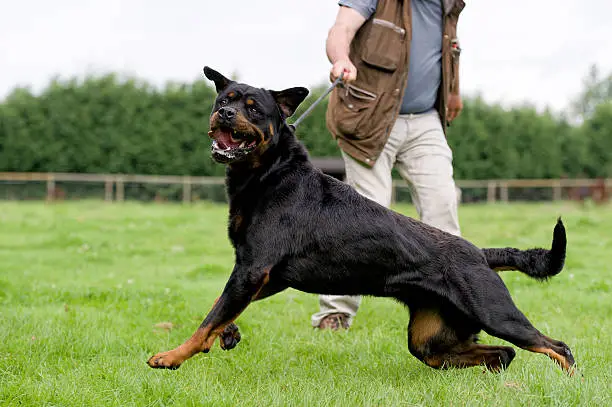Signs of hip dysplasia in rottweilers and treatment
Many Rottweilers suffer from hip dysplasia, a common and crippling ailment that causes pain, discomfort, and restricted movement. Unfortunately, Rottweilers have a larger chance of developing hip dysplasia than certain other breeds. As the illness worsens over time, it may have a significant effect on their quality of life. Understanding the symptoms and management of hip dysplasia in rottweilers is crucial since it is one of the most common orthopedic illnesses in dogs. Additionally, it is critical for both breeders and owners of Rottweilers to be knowledgeable about the reasons and available treatments for hip dysplasia.
The goal of this article is to give thorough information about hip dysplasia in Rottweilers. This also includes a list of warning signs and symptoms to look out for and an examination of the many potential treatments. We can enhance the quality of life for the pets we love and safeguard their wellbeing by developing a better knowledge of Rottweiler hip dysplasia. Come along.
Veken Pet Fountain is an Automatic Cat Water Fountain and Dog Water Dispenser with Smart Pump. The key to avoiding kidney and urinary tract illnesses is staying hydrated. For small to medium dog types and all cat species, the 95oz volume of this pet fountain water dispenser makes it the ideal choice. This drinking fountain is also made of BPA-free, sturdy, food-grade materials and is simple to use and maintain. You can keep track of how much water your dogs are consuming in real time thanks to the water-level window and LED light. Additionally, it enables you to determine precisely when the water dish needs to be filled. Buy now
Signs of hip dysplasia in rottweilers and treatment
Some ways to identify common signs of hip dysplasia in rottweilers and treatment include:
1. Modifications in Mobility and Gait
An odd waddle or limp in your Rottweiler might be a sign of hip dysplasia, so keep an eye out for any abnormalities in your dog’s stride. Furthermore, if your dog struggles to stand up, climb stairs, or leap, it might be an indication of hip joint stiffness.
2. Resistance to or difficulty rising or jumping
When a Rottweiler has hip dysplasia, they could have trouble or be reluctant to get up from a laying down posture, jump up onto furniture, or get into automobiles. This is brought on by the discomfort and stiffness in their hip joints.
3. Pain and discomfort during physical activity or exercise
Hip dysplasia may be the cause of your Rottweiler’s discomfort, lameness, or unwillingness to participate in once-fun athletic activities. While exercising, keep an eye out for any yelping, whimpering, or indications of pain.
4. Loss of Muscle Tone and Muscle Atrophy
In Rottweilers, muscular atrophy, or a visible decrease of muscle mass, especially in the rear legs, might be a sign of hip dysplasia. Muscle wasting may result from improper hip joint function, which can reduce muscle use.
5. A preference for one limb or lameness
A obvious indication of hip dysplasia in Rottweilers may include lameness, limping, or favouring one leg over the others. This is the dog’s attempt to reduce pain in the troubled hip joint.
6. An abnormal range of motion or position of the hip joint
Hip dysplasia may be indicated by an irregular hip joint range of motion or an improper hip joint position. It is also important to visit a veterinarian if you observe any abnormalities in the way your Rottweiler moves its hips.
7. Observable Hip Joint Clicking or Grinding Sounds
Hip dysplasia may be detected if your Rottweiler makes clicking or grinding noises while moving its hip joint. The instability of the joint and friction between the bone and cartilage are to blame for these noises.
8. Behavioral Modifications and Indices of Stress
In Rottweilers, hip dysplasia may lead to behavioral abnormalities. Due to ongoing discomfort and agony, they could become more agitated, hostile, or show indications of sadness or restlessness.
Screening procedures and diagnostic techniques
A veterinarian will examine your Rottweiler physically to determine if your dog has hip dysplasia, paying special attention to your dog’s stride, range of motion, and any indications of pain or discomfort. The dog’s medical background will also be taken into consideration.
Hip dysplasia is often diagnosed with radiographic imaging, such as X-rays. The veterinarian can see the hip joint and evaluate any anomalies thanks to this. The degree of hip dysplasia is also assessed using a variety of grading systems, which serves as a foundation for therapy suggestions.
To rule out any further underlying disorders or ascertain the severity of the hip dysplasia, extra diagnostic testing may sometimes be required. Blood testing, joint fluid analyses, and cutting-edge imaging methods like computed tomography (CT) scans and magnetic resonance imaging (MRI) are a few examples of these therapies.
Veken Pet Fountain is an Automatic Cat Water Fountain and Dog Water Dispenser with Smart Pump. The key to avoiding kidney and urinary tract illnesses is staying hydrated. For small to medium dog types and all cat species, the 95oz volume of this pet fountain water dispenser also makes it the ideal choice. This drinking fountain is also made of BPA-free, sturdy, food-grade materials and is simple to use and maintain. You can keep track of how much water your dogs are consuming in real time thanks to the water-level window and LED light. Additionally, it enables you to determine precisely when the water dish needs to be filled. Buy now
Exploring effective treatments and handling options
Although hip dysplasia may be a difficult disease for Rottweilers, there are a number of management and therapy options that can aid with pain relief and mobility. Here are some sensible tactics to take into account:
1. Weight control and a planned exercise regime
It’s critical for Rottweilers with hip dysplasia to keep a healthy weight. Excess weight may exacerbate the problem by putting extra pressure on the joints. Create a supervised exercise schedule with your doctor to keep your dog active without placing undue strain on their hips.
2. Painkillers and pain management techniques
To treat hip dysplasia-related discomfort, a variety of medicines are available. Non-steroidal anti-inflammatory medications (NSAIDs) may also ease pain by reducing inflammation. The best treatment and dose for your Rottweiler may be suggested by your veterinarian.
3. Alternative treatments like acupuncture
Chiropractic adjustments, acupuncture, and other complementary treatments may help reduce pain and enhance general health. These procedures may aid in pain management, induce relaxation, and help decrease inflammation.
4. Water treatment
Exercises in a pool or on an underwater treadmill are used in hydrotherapy to relieve the weight-bearing tension on the joints. In Rottweilers with hip dysplasia, the buoyancy of the water may also aid expand range of motion, strengthen muscles, and reduce discomfort.
5. Orthopedic supports and devices
Orthopedic tools, such braces or joint supports, may also provide the hip joint stability and support, easing discomfort and enhancing mobility. Regarding the compatibility of these gadgets for your Rottweiler, consult your veterinarian.
6. Mobility aids and assistive technology
The movement and access to higher surfaces may be facilitated for Rottweilers with hip dysplasia by aids like ramps, steps, and harnesses. These tools may lessen joint stress and enhance general quality of life.
Veken Pet Fountain is an Automatic Cat Water Fountain and Dog Water Dispenser with Smart Pump. The key to avoiding kidney and urinary tract illnesses is staying hydrated. For small to medium dog types and all cat species, the 95oz volume of this pet fountain water dispenser makes it the ideal choice. This drinking fountain is also made of BPA-free, sturdy, food-grade materials and is simple to use and maintain. You can keep track of how much water your dogs are consuming in real time thanks to the water-level window and LED light. Additionally, it enables you to determine precisely when the water dish needs to be filled. Buy now
Conclusion
In conclusion, identifying the symptoms of hip dysplasia in Rottweilers and obtaining an early diagnosis are crucial for successfully treating this problem. Rottweilers with hip dysplasia may have greater mobility, less discomfort, and a higher quality of life with the help of adequate veterinarian care, suitable treatments, and lifestyle changes. We can further ensure that our beloved Rottweilers live comfortably and joyfully for many years to come by remaining educated and taking preventative action.
Important Affiliate Disclosure
We at doglinked.com are esteemed to be a major affiliate for some of these products. Therefore, if you click any of these product links to buy a subscription, we earn a commission. However, you do not pay a higher amount for this. Rest easy as the information provided here is accurate and dependable.







